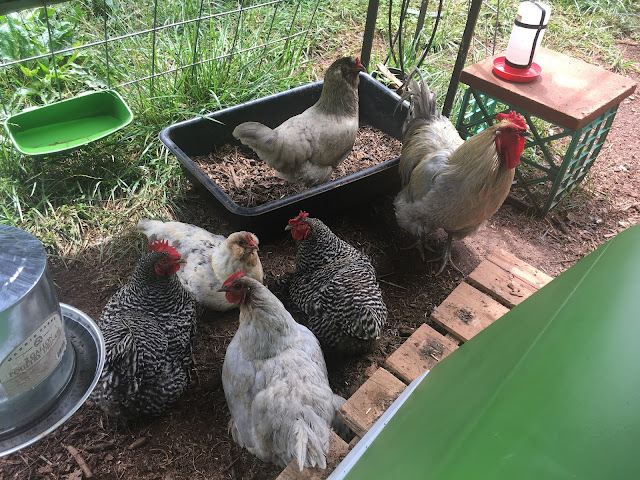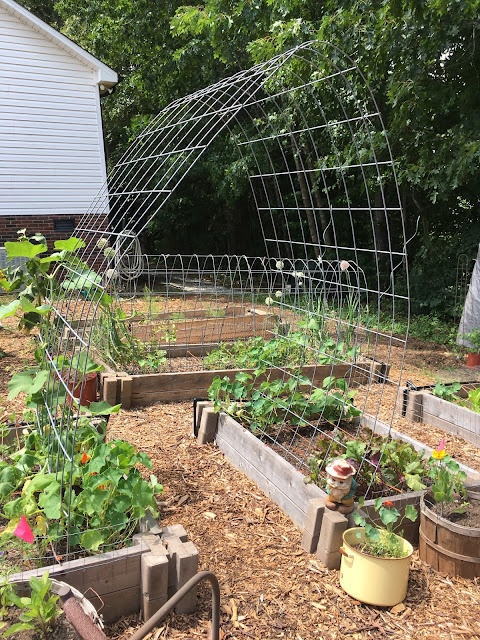Welcome back to Garden Friday,
where we share what's growing in our Piedmont garden.
The chooks are trying to keep cool this summer
by staying in the shade of the cattle panel cover.
They are also getting daily treats of ice cubes in their water
as well as frozen veggies.
The garlic, which had been harvested a few weeks ago
and left to cure in the garage for two weeks,
is now ready to use.
A good measure was given to sister,
who uses it religiously.
No fear of vampires in her house!
The onions are now taking up residence in our "spa" room.
They are resting on a pallet to cure for two weeks,
and then will be ready to use in all kinds of dishes.
Some may be chopped and frozen for future use.
One of the projects I've slowly been working on
is clearing out part of our "Kelsey's Woods",
(Any Andy Griffith fans out there?),
to make room for future woodland plants.
I'd love to fill up this space with hydrangea, hosta and other shade lovers.
The framed section you see in the middle of the photo
is our blueberry patch, complete with drip irrigation.
It's been so nice to happen upon a few ripe berries to munch on while I'm out there.
I'm having a hard time locating any more of these twisted wire stakes.
I have no idea where I first got them,
but they work wonderfully for climbing beans.
The search goes on...
The beans are slowly showing up on the vines,
and it's so exciting to see them all form in their own way.
I'm not sure what type of bean this is,
but I would guess it's some sort of drying bean,
from the shape of the pod.
This is definitely a green bean, or string bean,
and most likely the "slenderette" variety,
the tastiest green bean I've ever grown.
And lastly, in this bed, the rattlesnake bean,
which is a great drying bean.
The variegated pods are so colorful!
This is the first time we've grown these,
so I look forward to sharing my experience with them.
Having dried beans in the pantry is vital for me,
as I eat no animal protein and enjoy soups, stews and burgers
made with these flavorful nuggets.
the loofah is finally taking off.
It will cover the gazebo frame in the chicken run,
and give the chooks more shade to enjoy through the heat and humidity.
I may even give them some of the fruit to see if they like it.
It can be eaten when it is smaller, around 4-6 inches,
just as you would zucchini.
We do plan to leave some on the vine to harvest for using as sponges.
Another cattle panel arch was added between two of the 4 X 4 beds
to accommodate our growing squash vine.
Adding vertical growing space not only saves room in the beds and surrounding walkways,
but it keeps the foliage off of the ground,
which can lead to fungal and pest pressure.
There are at least two different varieties of squash growing in this bed,
and so far, (knock wood), I haven't found any squash bugs or eggs on the leaves.
I make it a point to do a nightly check on the foliage,
to try to stay on top of it.
The garden is in a new location this year,
so maybe that is helping with pest control.
I see squash soup in my future!
One of the partial cattle panel frames that was being used over the winter
with row covers,
is being repurposed to help support our sweet potato vines.
They are just getting started,
but with the onset of more heat, they no doubt will be hard to stop.
The final crop was sown this week.
Two types of pumpkin seeds were planted
in the bed where we harvested our onions.
I have thus far not had much luck in growing pumpkins,
but that doesn't mean I've given up trying!
Most likely, I will add a cattle panel trellis to the bed,
so that the plants can grow vertically and stay off the ground.
after using the pumpkins to make all sorts of goodies.
They can be eaten after roasting in the oven,
or saved to replant next year.
This little fuzzy fellow stays hunkered down next to our air conditioner.
Whenever I'm out there, I see him scurrying around.
I'm not sure if it's a wooly bear caterpillar,
but I read about this critter's legend:
"According to folklore, the amount of black on the woolly bear in autumn
varies proportionately with the severity of the coming winter. The
longer the woolly bear's black bands, the longer, colder, snowier, and
more severe the winter will be. While the wider the middle brown band
is, means it will be a milder upcoming winter."
Find out more about this here.
What do you think?
Do you know anything about this fuzzy wuzzy?
Do tell!

















It's all looking so good. Lots of good eating there! I've heard the woolly bear story, but don't know how accurate it is. I guess I've never paid attention to see. I hope you're getting some of this lovely rain.
ReplyDeleteWe were blessed with over an inch of rain yesterday! There's just nothing like it. My pumpkin's popped right up!
DeleteHave a wonderful weekend.
Hi Daisy
ReplyDeleteJust popping in to see what you've been up to in recent months. The time is certainly going fast---you've got a lot of beautiful things growing there---including chickens! Marvelous!!
Hope you have a terrific summer
Sue
It's always good to hear from you, Sue. I'm wondering if the heat has managed to reach you way up there?
DeleteHope you are doing well.
Your "new" garden looks beautiful! And that garlic! Wow! And that flock! What a lovely group. Regarding the squash bugs, have you ever tried putting a small piece of wood flat on the ground next to your squash plants? The squash bugs will go under it for cover overnight and if you turn it over every morning that also will let you know if you have any. You can kill them all before they get on the plants for the day. Have a wonderful weekend!
ReplyDeleteGreat tip! I have been meaning to put some boards in the beds to attract slugs. The hens love 'em!
DeleteThank you for stopping by!
Wow, your garden is looking great! I'm so impressed by your garlic and onion harvests--what a lovely bounty--and your chickens are just gorgeous. There are so many pest problems in a Florida garden. Just curious--are you finding gardening any less challenging farther north?
ReplyDeleteThank you for the kind words, Leslie. I think there are pest problems everywhere. We do have some relief, I believe, because it gets colder here. We just do the best we can!
Delete